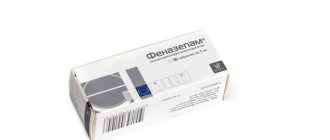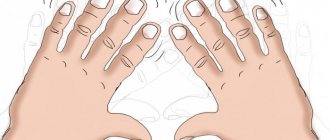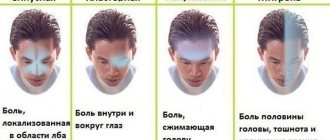In some cases, this condition is caused by the use of medications (for example, dilating the pupil), external factors, or diseases of the visual system. But, in any case, different degrees of this pathology are familiar to each of us, because we all feel photophobia when we leave a dark room into bright light. However, when a feeling of visual discomfort occurs for no apparent reason, it cannot be ignored. In this case, you should seek special help as soon as possible.
Causes
Photophobia can be caused by ophthalmological abnormalities, internal systemic disorders and exposure to external factors. Ophthalmic causes include:
- conjunctivitis – inflammation of the mucous membrane of the eye. It is accompanied by pain in the eyes, redness of the whites, and purulent discharge. Photophobia can occur in both chronic and acute forms. Find out about the symptoms and treatment of uveitis in this material;
- iritis - inflammation localized in the iris;
- keratitis - damage to the cornea;
- eye injuries;
- ulcers and tumors in the eye area;
- corneal erosion due to foreign body penetration;
- retinal disinsertion;
- acute attack of glaucoma (sharp increase in intraocular pressure).
In most cases, it is visual pathologies that cause the development of photophobia. What is photopsia can be found here.
General disorders and pathologies:
- prolonged migraines;
- ARVI;
- diseases that are accompanied by brain damage: rabies, botulism, measles;
- photophobia as a side effect after surgery;
- consequences of long-term use of drugs such as Furosemide, Quinine, Tetracycline;
- albinism: a rare congenital anomaly in which the iris of the eye is devoid of pigment, which is why the rays of the sun penetrate not only through the pupil, but also through it.
External factors:
- long exposure to the sun;
- violation of the rules for using a solarium;
- long periods of work at the computer
- sun or thermal burns;
Photophobia often develops in people who regularly use contact lenses. But this only happens if the optics are selected incorrectly. In this case, irritation of the cornea begins, which ultimately results in increased lacrimation and severe pain in the eyes.
There is not only acquired, but also congenital photophobia. It occurs due to the partial or complete absence of melanin.
Sometimes photophobia can be short-lived; this should not cause panic. Changes in lighting, prolonged reading, a short episode of photophobia, as a postoperative symptom - all this is not a pathology, but only if it does not continue systematically and for a short period of time. When this symptom does not disappear and is permanent, this is a reason to visit a doctor. Find out how to treat chorioretinitis by following the link.
Photophobia of the eyes: causes
This problem can occur due to a variety of circumstances, including the following:
- congenital features of the eyes - for example, people with albinism often suffer from this;
- working at a computer for a long time, in a room with poor lighting or dry air - all this puts strain on the eyesight;
- taking certain medications, especially those that dilate the pupils;
- heliophobia, that is, fear of the sun and the inability to go outside while it is shining;
- infectious diseases, ophthalmological diseases and problems with the nervous system;
- developmental abnormalities of the eyeball.
Sometimes the reasons are much simpler than they seem at first glance: for example, a child may develop photophobia because a grain of sand or other small foreign body got into his eye while playing. Then you just need to get rid of this interference - and soon the perception of light will return to normal.
Sometimes photophobia occurs after eye surgery - there is nothing wrong with that, you just need to follow the doctor’s recommendations and wait a little.
Symptoms
Photosensitivity can affect one or both eyes. In this case, the following symptoms are observed:
- deterioration of visual acuity;
- feeling of sand in the eyes;
- blurred outlines of objects;
- redness and swelling of the mucous membranes;
- abnormal pupil dilation;
- paroxysmal headache;
- profuse lacrimation.
When a bright source of light appears, patients suffering from photophobia reflexively close their eyes or cover them with their hands.
As mentioned earlier, in most cases, photophobia is a sign of the development of visual pathologies. The following signs indicate the presence of diseases of an ophthalmological nature:
- prolonged redness of the whites of the eyes;
- swelling of the eyelids;
- suppuration in the eye area.
In order to accurately determine the nature and cause of the disease, it is necessary to undergo an ophthalmological examination. The disease cannot be eliminated at home. How exophthalmos manifests itself can be found in the article.
Diagnostic methods
During the examination of the visual organs, the following techniques can be used:
- ophthalmoscopy – examination of the fundus of the eye;
- biomicrosopia – examination of the fundus and vitreous body for changes;
- perimetry – establishing visual fields;
- tonometry – measurement of intraocular pressure;
- gonioscopy – examination of the anterior chamber of the eye to measure the canthal angle;
- pachymetry - manipulation to assess the thickness of the cornea;
- Ultrasound allows us to examine the transparent environment of the eye;
- angiography is prescribed if it is necessary to study the patency of the blood vessels of the eye;
- electroretinography is used to obtain a complete assessment of changes in eye tissue;
- optical tomography is used to detect changes in the retina;
- bacteriological examination of the contents of the conjunctival sacs allows the PCR method to detect the presence of pathogens.
If the condition of the visual organs does not cause any complaints, then the patient should undergo a neurological examination. This will require a consultation with a neurologist and additional research:
- MRI of the brain;
- electroencephalography;
- Dopplerography of neck vessels.
Sometimes a consultation with an endocrinologist is prescribed, this is done in order to rule out hyperthyroidism or the diabetic nature of photophobia. For this purpose, laboratory blood tests are prescribed for thyroid hormones - TSH, T3 and T4.
What to do before consulting a doctor
In order to reduce painful sensitivity, the patient is recommended to adhere to the following recommendations:
- wear sunglasses. This will significantly reduce discomfort and the symptoms will not be so noticeable;
- minimize eye contact with hands to avoid introducing additional infection there;
- maintain visual hygiene;
- use moisturizing eye drops;
- reduce the time spent at the computer, use special glasses for work and periodically take breaks with eye exercises.
All of the above methods are temporary measures. Without proper therapy, photophobia will not go away.
Treatment of photophobia
Treatment for this condition consists of eliminating the cause that caused it. If it is not possible to completely cure the disease, for example, the patient has albinism, then it is necessary to make adjustments to your life to reduce the signs of photophobia. When going outside on bright sunny days, you should only wear sunglasses that have good sun protection. Eyeglass optics must be of high quality and perform their protective function well, so they should only be purchased in optical shops and specialized stores. When purchasing, make sure that the model you need has a passport indicating the degree of darkening of the lenses. It is also a good idea to wear a wide-brimmed hat when under the scorching sun.
If the cause of photosensitivity is temporary, for example, it appears during a cold or migraine, then you can alleviate your condition with the help of eye drops. Only an ophthalmologist can prescribe them for use. The dosage and course of treatment are also calculated individually by a specialist.
MagazinLinz.ru team
Treatment
Therapy for photophobia directly depends on the cause that caused it, and based on this, the course of treatment is selected. For this, moisturizing drops, local antibiotics and antiseptics, as well as glasses with polarized lenses can be used.
Using glasses with polarized lenses
To understand the need to use polarized glasses, you first need to consider the distribution of light rays.
The latter have the ability to be reflected from the surface of objects and continue their movement in the vertical and horizontal directions. Vertical flows do not harm a person’s vision and do not create any discomfort, while horizontal flows create glare and block the visible image. To remove harmful horizontal rays from the spectrum, you need glasses with polarized lenses. They are a multilayer optical structure with a transparent film (polarizing filter) built into it. It makes it possible to eliminate the negative impact of horizontal rays and at the same time does not interfere with the normal vision of surrounding objects.
It is recommended to use such optics in combination with drops or antibiotics until the root cause of photophobia is completely eliminated.
Let's look at the key brands of polarized optics:
- Snowbee. The most common and affordable brand. Unfortunately, it is not distinguished by either a wide variety of models or particular strength. Cost up to 700 rub.
- Solano. It is also one of the popular brands, but is distinguished by an impressive selection of models and high quality. Cost up to 2500 rub.
- Smith-optics. The glasses have a long service life and are resistant to high temperatures and mechanical damage. Cost from 5000 rub.
Drops and gels
When treating photophobia, the eyes require additional hydration and protection. The following drugs are used for these purposes:
- Vidisik. Eye moisturizer, available in gel form. The active component is a carbomer, a polymer that has an acidity identical to human tear fluid. The drug is applied under the eyelids at regular intervals (2-3 times a day). If insertion is carried out in the evening, then this must be done at least half an hour before bedtime. During treatment, the use of soft contact lenses is not recommended; hard ones must be removed before insertion. As for contraindications, these include individual intolerance to the components. As an alternative, you can use Systane Ultra drops.
The gel cannot be combined with other ophthalmic drugs.
- Oksial. Eye drops based on hyaluronic acid and electrolytes to relieve irritation and dry eyes. The product has a viscous consistency, as close as possible to human tear fluid. This promotes cell regeneration and relieves eye irritation. The drug also has a healing effect. Instillation of the drug should be done 2-4 times a day. The permissible dosage is no more than 2 drops in 1 eye. The general period of use is from 3 weeks to a month. Contraindications include individual intolerance to the components.
- Katinorm is also used when the surface of the eye dries out, resulting in burning, itching and foreign body sensation. The drug can be instilled no more than 4 times a day, one drop in each eye. After instillation, you need to blink intensively so that the drug is evenly distributed over the surface of the eye. Contraindications – individual intolerance.
Antibiotics and antiseptics
Antibiotics and antiseptics are prescribed if photophobia is caused by an infectious eye infection: conjunctivitis, keratitis, iritis. Let's look at the main ones:
- Tobradex – combined antimicrobial and anti-inflammatory eye drops. Used to eliminate dacryocystitis, barley, keratitis, blepharitis and conjunctivitis. At the beginning of treatment, the drug should be instilled every 2 hours, but no more than 2 drops at a time. After 2-3 days, the interval between instillations can be reduced to 6 hours. The duration of treatment is prescribed by the attending physician. Note that if during the first 3 days the drug does not have any effect, then it must be replaced. You can also use Albucid drops, discussed here.
The product is contraindicated for use in children under 12 years of age, during pregnancy and lactation, if the eye damage is tuberculous or fungal in nature.
- Dexamethasone is an eye drop that has an anti-inflammatory, anti-allergic effect. Used to relieve inflammation after injuries and burns. The product must be instilled every 2 hours, 1 drop. On day 3 of therapy, instillations should be made every 5 hours. The maximum duration of the course is 2 weeks. Contraindications include: glaucoma, trachoma, fungal infection of the eyes, mycotic lesions of the organs of vision, diseases of tuberculosis origin, suppuration in the cornea. The product should not be used during pregnancy, lactation, or children under 6 years of age.
- Levomecithin is an eye drop based on chloramphenicol, a broad-spectrum antibiotic. Used to eliminate stye, keratoconjunctivitis, conjunctivitis, blepharitis, keratitis. Instillation should be done 1 drop 3 times a day. The medicine is contraindicated during pregnancy and lactation, with renal and liver failure, and in children under 2 years of age.
If I have laser correction, will I have photophobia?
Increased sensitivity of the eyes to light is called photophobia or photophobia. This is any discomfort from light, both solar and artificial. It manifests itself in the form of pain, redness, dryness or, conversely, tears. There may be an involuntary urge to squint. What causes ocular photophobia and can laser correction provoke it?
Causes of photophobia
Sometimes photophobia can be an individual characteristic of the body due to heredity. Scientists have noticed that people with light-colored irises or albinos, who have no pigment in the iris at all, have photophobia more often than dark-eyed people. Most often, photophobia is acquired and indicates a violation of visual function. In their studies, ophthalmologists cite the most common causes of photophobia:
Photophobia is a sign of visual impairment.
- inflammatory eye diseases;
- incorrect selection of contact lenses;
- abnormalities of the eyeball;
- eye injuries;
- corneal erosion;
- laser correction.
Photophobia after laser correction is a natural reaction to tissue damage. During the operation, the corneal layer is separated. Once the injured area heals, the side effects will go away. In addition to photophobia, after laser exposure, the patient may experience: tingling, foreign body sensation, lacrimation.
Photophobia and laser vision correction
Sensitivity to light after laser vision correction is common. This is not a complication, but the norm. Photophobia can persist for several hours and cause pain in the eyes. On average, two hours after the procedure it passes, and the patient is sent home. He must wear sunglasses for the first time after surgery.
Treatment of photophobia
After laser vision correction, photophobia does not need to be treated; it will go away on its own. In other cases, the first step in eliminating photophobia will be to identify the root cause, the disease that triggered it. If bright light begins to cause pain in the eyes or discomfort, you need to be examined by an ophthalmologist. After a comprehensive vision examination and diagnosis, you will be prescribed treatment. We have already told you what procedures are included in a detailed eye examination.
Photophobia will go away on its own after laser correction. This consequence is the norm.
Prevention of photophobia
Simple recommendations will help reduce the risk of developing photophobia of the eyes:
- Use sunglasses. Choose high-quality lenses, use glasses all year round, not just in summer.
- Wear a wide-brimmed hat.
- Use glasses when working on a computer.
- If dry eye syndrome occurs, instill tear drops.
Laser vision correction cannot cause the development of photophobia and vision impairment. A person sees using the fundus of the eye, retina, and optic nerve. And during the operation, the corneal layer is exposed. Detailed material on how the operation takes place can be found on our website.
Summarize:
- Photophobia is the increased sensitivity of the eyes to light.
- Photophobia can be either an individual trait or a consequence of a disease. An ophthalmologist will help you figure this out.
- Photophobia is treatable.
- After laser vision correction, photophobia is normal and common. It will go away as soon as the tissue heals.
Photophobia in children
In the vast majority of cases, the cause of photophobia in children is increased visual fatigue. It can occur due to lack of sleep, stress, prolonged use of the computer, etc. Infectious eye diseases (infectious, tuberculous-allergic, fungal conjunctivitis), mechanical or chemical damage to the cornea are also provoking factors.
In rare cases, the cause of photophobia is the so-called “pink disease” (acrodynia). Its signs are redness and stickiness of the feet and hands, profuse sweating, and decreased appetite. Pathology is observed only in children.
Diseases associated with photophobia
Photophobia can be a consequence of infectious diseases such as:
- Measles
- Rubella
- Meningitis
- Clinical depression
- Migraine.
Involuntary closure of the eyelids (blepharospasm) can also occur with neurological diseases.
Inflammatory processes can also cause photophobia, namely
:
- Inflammation of the eyelids (blepharitis)
- Inflammation of the cornea (keratitis)
- Inflammation of the conjunctiva (conjunctivitis).
Due to prolonged inflammatory processes in the visual system or after injury, the nerve endings in the cornea can change and corneal neuropathy may appear, which causes photophobia.
Visual photophobia can occur when:
- Papilledema (neuritis)
- Inflammatory process in the choroid of the eye (uveitis) or iris (iritis).
A large list of diseases accompanied by photophobia is direct evidence that at the first symptoms you should immediately consult a doctor.









